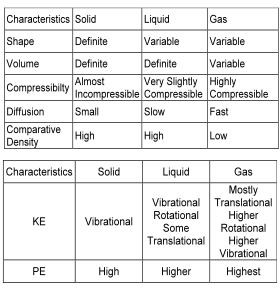Cards In This Set
| Front | Back |
|
3.1.1
State that temperature determines the direction of thermal energy transfer between two objects |
Temperature determines the direction of thermal energy transfer between two objects. Direction: hot->cold
|
|
3.1.2
State the relation between the Kelvin and Celsius scales of temperature |
TK = TC +273.16
|
|
3.1.3
State that the internal energy of a substance is the total potential energy and random kinetic energy of the molecules of a substance |
Internal Energy is the potential energy and random kinetic energy of the molecule of a substanceInternal Energy = PE + KE
|
|
3.1.4
Explain and distinguish between macroscopic concepts of temperature internal energy and thermal energy (heat) |
Temperature: degree of hot/cold
Internal Energy: PE + KE (molecules move) Thermal Energy: transfer of energy |
|
3.1.5
Define the mole and molar mass |
Mole – the amount of substance that contains as many atoms as there is in precisely 12g of carbon-12
Molar Mass – The amount of grams per unit mole given by the mass number of a specific element |
|
3.1.6
Define the Avogadro constant |
Avogadro constant is the number of atoms or molecules in one mole of a substance
OR 6.02 X 1023 particles |
|
3.2.1
Define Specific heat capacity and thermal capacity |
Specific Heat Capacity – is the energy required to raise a unit mass of a substance by 1℃ or 1K. OR Q=mc∆T
Thermal Capacity – is the energy needed to raise temperature of a substance by 1℃ or 1K. Q=c∆T |
|
3.2.3
Explain the physical differences between the solid, liquid, and gaseous phases in terms of molecular structure and particle motion |
 Refer to the picture for details |
|
3.2.4
Explain the process of phase changes in terms of molecular behavior |
(melting point)
- When the solid is heated the particles of the solid vibrate at an increasing rate as the temperature is increased - The vibrational KE of the particles increases - At melting point, the PE of the system increases as the particles move apart (boiling point) - Temperature between melting point and boiling point -> increases - At boiling point, particles gain energy to overcome intermolecular forces - PE increases - Heating continues until every particles change phase to gas |
|
3.2.5
Explain in terms of molecular behavior why temperature does not change during a phase change |
During phase change, energy is continuously provided, but temperature does not increase because energy is used to break intermolecular forces between particles. Instead of increasing average kinetic energy, the heat added transfers to increase in potential energy
|
|
3.2.6
Distinguish between evaporation and boiling |
Water boils at 100℃ but evaporates at all temperatures. Evaporation happens when faster moving molecules escape of change from liquid to gas at the surface, so the average kinetic energy declines, and so temperature declines
|
|
3.2.7
Define Specific Heat |
Specific heat is the amount of heat required to change phase of a substance
OR Q=mL L – latent heat (Jkg-1) |
|
3.2.9
Define pressure |
Force per unit area
Unit: Nm-2 1atm = 1.013 X 105 Pa or 101.3kPa |
|
3.2.10
State the assumptions of the kinetic model of an ideal gas |
1. Newton’s law apply to molecular behavior
2. There are no intermolecular forces 3. The molecules are perfect spheres 4. The molecules are in random motion 5. The collisions between the molecules are elastic (no energy is lost during collision) 6. There is no time spent in these collisions (very short duration) |
|
3.2.11
State that temperature is a measure of the average random kinetic energy of the molecules of an ideal gas |
Temperature is a measure of the average kinetic energy per particles of an ideal gas
|



